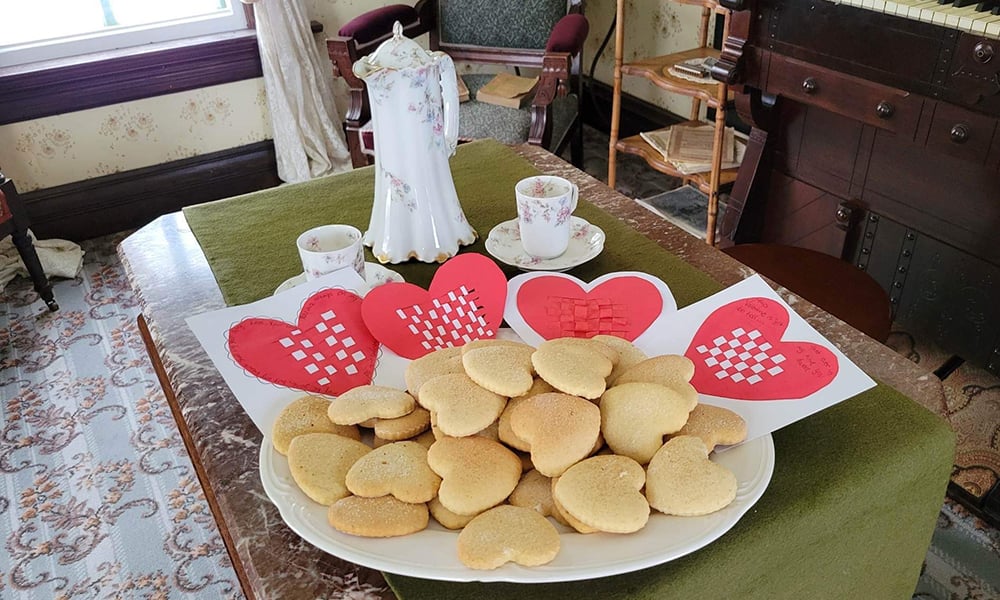
Valentine's Day had already gained popularity with American school children by the early 1880s, and many of the traditions from the time we still hold true today.
By then, school children were in the practice of gifting classmates with homemade tissue paper hearts accented with doilies and ribbon or with cards adorned with glued scrap-paper paisley designs. These handmade valentines were thought to be far superior to purchased ones. Envelopes were embellished with feathers, leaves, lace, candy, tissue, and dried flowers.
Crocheted hearts, bows, wreaths, and love knots were popular symbolism as were white doves, silver and gold arrows, and horseshoes. Special messages were also adorned with crocheted edges for that homemade touch.
Red, white, and pink heart-shaped candies and cakes were sweet treats one would make for their special valentine. Chocolate — whether in hot cocoa, cookies, or taffy — was romanticized for its richness. Young teenage farmgirls would have overnight stays, create these sweet treats, and romanticize about an idealized future life.
In the 1880s and 1890s both men and women were required to know the etiquette of courtship, though periodicals were consistently changing the rules. Marriage was a major rite of passage in young life, and divorce was not really an option.

A copy of an authentic stereograph love-themed card from Kline Creek Farm's collection
A young lady between the ages of 14 and 16 would change her appearance to indicate her availability for courting. She would pin up her hair and wear a proper corset with an almost floor-length skirt.
Farm boys exhibited their adulthood by greasing their hair with lard and purchasing their own pocket watches with money made from farming their own acreage.
Both young men and women were advised and well-instructed by family, “experts,” doctors, and clergy on what to look for in a potential partner. It was imperative to consider both the physical and mental health of a prospective mate. If a problem were discovered, the relationship could be dissolved before it was made public or official.
In late Victorian times, Valentine’s Day was an acceptable time to court a young lady at her farm. If the arrangements were made properly, the gentleman farmer would meet the young lady’s parents at the parlor door, and a brief social time of 15 to 20 minutes was granted.
The couple wouldn't have used each other's first names and would have been introduced as miss or mister. As courting continued, additional time and activities were introduced, such as charades, singing songs, musical chairs, and even playing duets on the pump organ where one’s hands might cross over and touch the other's during a song.

Young couples were granted roughly 20 minutes of social time when meeting.
Courting in groups with other young people, some married, allowed couples to be chaperoned for leisure activities such as roller skating and ice skating, where a man might have to give his arm to a woman in a long dress to catch her balance. Other group social activities included sledding, bonfires, bicycle riding, and row boating. Saturday night dances were a popular highlight of the social season in many rural communities. Ladies were given dance cards upon arrival, and men would sign individual ladies' cards to reserve dances with specific ladies. An unchaperoned buggy ride in the evening was forbidden.
Calling cards, which could be purchased through mail-order catalogs or local merchants, were also popular in the 1890s. A farm man would leave his card on the parlor porch of a young lady he wished to court to communicate his social status and desire for a brief visit. The young lady would respond with her mother’s card at first to indicate acceptance of proper protocol.

A couple embraces at a piano in the early 20th century.
When the young farmer came calling, only nonpermanent gifts like flowers or chocolate were acceptable. (Flowers die, and chocolate is eaten.) As the relationship progressed, meaningful gifts were handmade and, of course, included wonderfully written Victorian valentines. As one young farmer wrote his feelings to his fiancée on Feb. 14, 1900, “My love for you is as pure and holy as yonder star is eternal, for life without you would be intolerable, death a release!”
The voluminous exchange of love letters between farm couples has created some of the best written poetry in history. The Victorians’ passionate declarations of love and a promised spiritual life with perpetual happiness were written daily by both men and women and not just in February. These letters gave insight into the expectations of romantic love as a prelude to marriage.
In extreme contrast, "vinegar valentines," made popular in the 1840s, were cynical, sarcastic, mean-spirited, insulting postcards that cost the receiver — not the sender — a penny for the privilege of being ridiculed, often anonymously. These “penny dreadfuls” featured garish caricatures of cartoonish people, often with inappropriate language. As literacy rates increased among the poor, vinegar valentines became more popular because of their low price.
Wayne Hill
